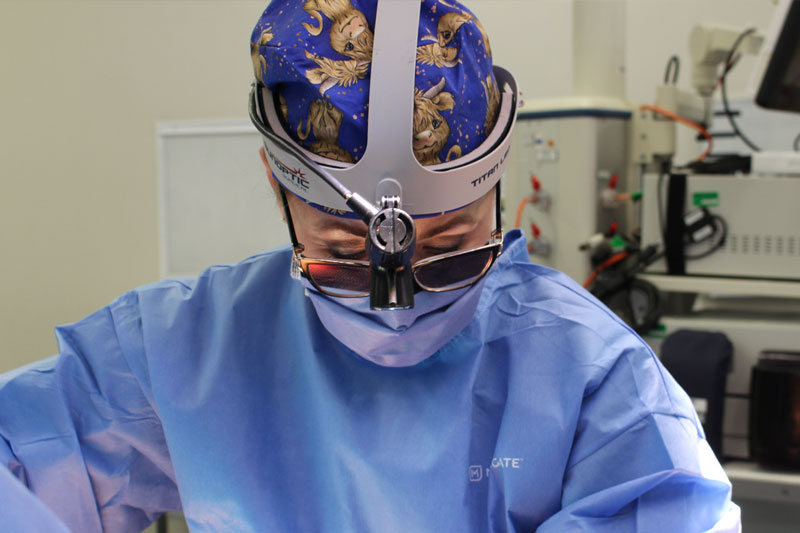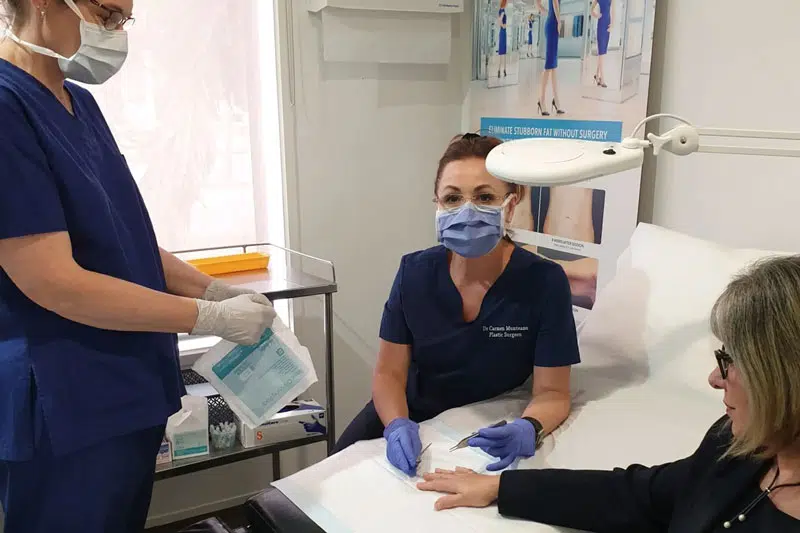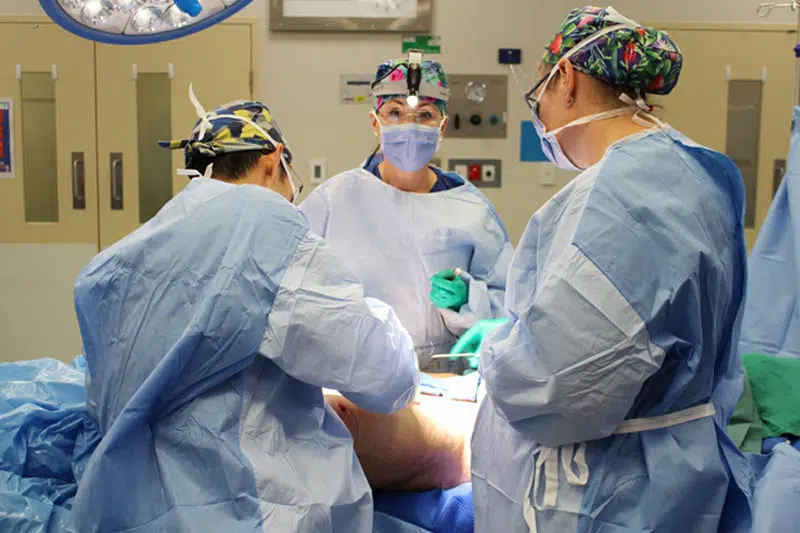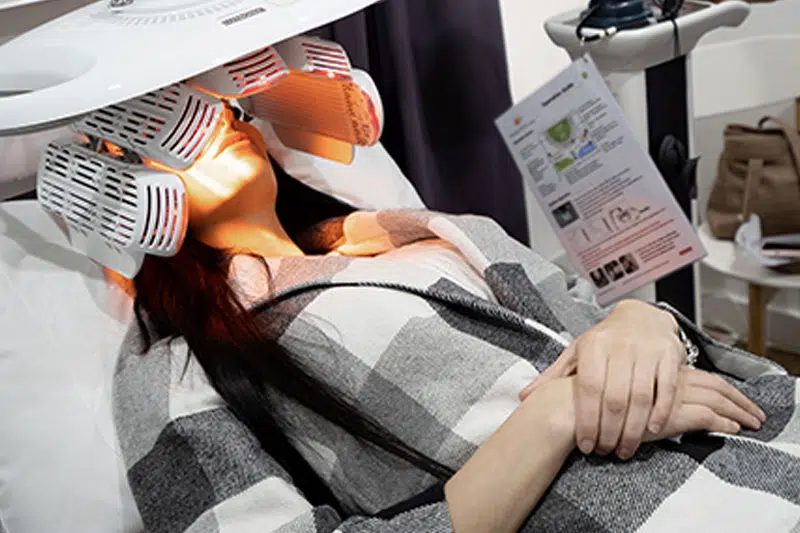Male Breast Reduction or Gynecomastia surgery can help remove man breasts to smooth and contour your chest. Dr Carmen is a Gyno expert and Specialist Plastic Surgeon in Melbourne. It is very important to closely follow the recommended process for recovery after Gyno so you can heal quickly and get optimal results.
While the recovery time varies from person to person based on the amount of excess tissue removed, the post-op instructions are the same. On average the recovery time will last 4-6 weeks. Let’s have a look at the recovery timeline for gyno or gynecomastia.
Download Dr Carmen’s Guide to Male Breast Reduction – Gyno or Gynecomastia Surgery
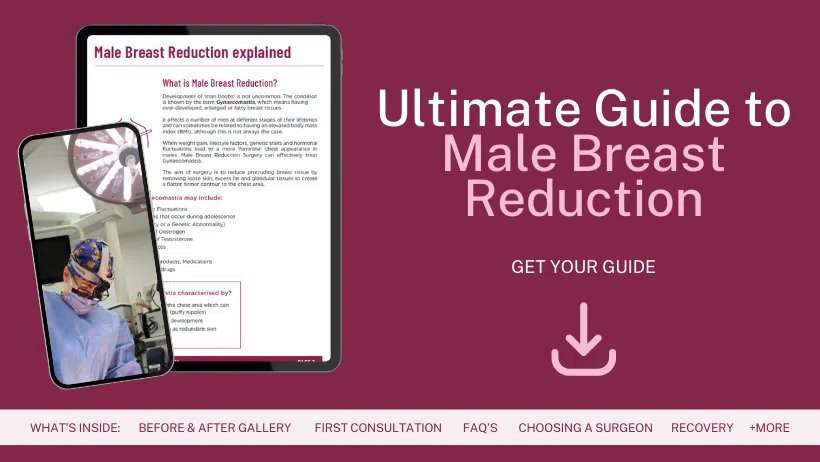
Timeline for Recovery after Gyno – Gynecomastia Surgery
2-3 Days Post Gynecomastia
You will experience slight pain, numbness and tenderness in your chest area for the first few days after the surgery. The surgeon will also prescribe some pain killers and antibiotics to aid you with a smooth recovery. Some patients might also feel nauseous from the effects of anaesthesia. You will be able to notice the results immediately after the surgery. However, the swelling will still be quite pronounced for the first few days post-surgery. You should rest completely and allow your body to heal at a faster pace. If you can, get someone to help you around the house.
1 Week Post Gynecomastia
After one week passes, your pain and discomfort will subside significantly. You can return to your work if it is not physically demanding. Stay clear of any activities that put stress on the pectoral muscles. If you have non-dissolving stitches, your surgeon will remove the stitches at this point. Continue to wear your compression garment and avoid sleeping on your stomach and side.
2 Weeks Post Gynecomastia
By the end of week two, you will feel like yourself and you can resume all your usual activities. Stay clear of any vigorous exercises. You can start sleeping on your side after a discussion with your surgeon.
3-4 Weeks Post Gynecomastia
Most of the swelling will subside by week four. You can stop wearing a compression garment after four weeks. Your incisions will heal fully and you can continue taking baths. The swelling and bruising on the chest will be completely gone by week four. You will be able to see the true results of the surgery.
6 Weeks Post Gynecomastia
Six weeks marks the end of the recovery phase. You can resume your exercise routine as well as all kinds of strenuous activities. You can also sleep in any position you like and resume your day to day routine.
Post-Gynecomastia Instructions – Tips for Recovery after Gyno or Male Breast Reduction
Here is a recovery guide you need to stick to post the surgery.
1. Managing Nausea
Your surgeon will make sure that you don’t feel nauseous after the surgery. However, some patients are more sensitive to anaesthesia than others. If this is the case, talk to your surgeon and get medication to control it. On a more natural side, drinking ginger and lemon tea also helps with anaesthesia. Make sure to take all the meds with meals to avoid feeling nauseous.
2. Start with Gentle Activity only
You will be asked to rest completely for the first three to four days. Once you feel well enough to grab a bite by yourself, use the bathroom comfortably, you should start walking lightly around the house for about 10 to 15 minutes per day. It will help with circulation and prevent blood clotting. After the two-week mark, you can return to walking and light exercising. Do not lift heavy weights till six weeks or till your surgeon gives you approval.
3. Stay Hydrated
Hydration is very important for your health especially post-surgery. Keep a water bottle with you at all times and drink it constantly.
4. Sleep well
We heal while we sleep. However, there is a right way to sleep post-surgery. Sleep on your back at a 45-degree angle for the first three to four days. You can sleep with your back straight for the first two weeks. It is very important as sleeping on your side or stomach can put a strain on your incisions. If you find it difficult to fall asleep, discuss this problem with your surgeon and he/she might prescribe you a sleep medication. Aim at sleeping eight hours a day.
5. Wear your Garment & Dressings as directed
For the first 2 days, your chest will be covered in bandages, followed by a post-surgery garment. Your surgeon might call you for a follow-up visit to remove the bandages and ensuring that there are no signs of infection. Your doctor might ask you to use pads in case of oozing. In certain cases, the doctor will ask you to wear a binder for the first three days. If that is the case, it is important to adjust your binder every few hours. Make sure it isn’t too tight as it can restrict the blood flow.
Always wear a compression garment at all times for at least four weeks post-surgery. It reduces swelling and helps you heal faster.
6. Showering & Bathing
It is best to avoid showering for the first 24 hours after the surgery. It is recommended to take a sponge bath for the first two days. After that, you can shower as usual. Just do not aim the water directly at your chest and avoid getting the incisions wet. Do not take baths as it can risk infections. Dry your skin gently with the help of a soft towel. It is important to keep your incisions clean and dry at all times.
7. Go easy on the Ice Packs
A lot of people are concerned about whether they should apply ice packs on their skin or not. While cold compression is a great way to minimize swelling, you need to be very careful. Do not apply ice directly to the skin. Always wrap it up in a towel and use it for a few minutes at a time. Your chest will still be numb for a few days post-surgery so be careful not to burn it.
8. Care for your Incisions
Most of the surgeons will use dissolvable sutures which will dissolve on their own. For the first few days, you will have surgical tape over the stitches which will ensure optimal healing. Keep your incisions clean and dry at all times and take your meds on time.
9. Driving is restricted
You must have a friend or a family member drive you home on the day of the surgery. It is best to avoid driving yourself for at least three to five days post-surgery.
10. Avoid Blood Thinners
Do not take any blood-thinning medications for at least two weeks after the surgery as it can lead to bruising.
11. Limit Exercise
You shouldn’t be exercising for at least two weeks after the surgery. After that, you can resume all kinds of exercises except the ones that focus on your chest. With that being said, avoid lifting heavy weights for at least six weeks or till your surgeon gives you a go. Do not do anything that causes extreme discomfort. If something feels unnatural, it’s time to take a break.
12. Return to Work depends on your Occupation
Most of the people can return to work within two weeks’ time frame. If your job is physically intensive, it is advised to take at least two or more weeks off from work. It is important to remember that everyone heals at a different pace. Be patient with yourself and allow your body to heal at its own pace.
13. Limit Sun Exposure
Most people do not think much about going out in the sun but it is best to avoid doing so. Exposing your incisions to the sun can make them darker. If you are concerned about post-surgical scars, wear sunscreen while going out. If you can, skip going out in the sun altogether.
14. Avoid Smoking/Alcohol
Quit smoking and drinking for as long as possible before and after the surgery. It can significantly affect your recovery, increase bruising and slow down healing. It is difficult if you are a regular smoker/drinker but necessary to your recovery. Smoking after surgery can delay healing for months and cause many serious complications like tissue death.
15. Take your Medications as directed
Take all the medications on time as directed by your surgeon if you wish to have a smooth, pain-free and infection-free recovery. If at any point during the recovery, you feel excessive pain, immediately get in touch with your surgeon.
16. Post-op Bruising
In some patients, excessive bruising is very common. If the bruising doesn’t go away completely within two to three weeks, discuss this with Dr Carmen. She will prescribe you topical ointments to get rid of bruising. Taking Arnica tablets or applying arnica cream may help reduce bruising after your wound has healed.
17. Choose Comfortable Clothing
Wear a compression garment for at least four weeks. Wear loose, comfortable and breathable clothing. Avoid wearing anything too tight or uncomfortable.
18. Nutrition and Diet help healing
Avoid eating processed food items. Limit your sodium intake. Consume plenty of fruits and vegetables. Eating right will nourish your body from within and will help you heal at a faster pace. For a better result – eat right!
19. Attend your Follow Up Appointments
Many people make the mistake of skipping a follow up appointment. These Follow-up appointments are critical to ensure everything is fine, your incisions are healing properly at a normal pace.

Warning Signs You Need to look for during recovery from Gyno Surgery
Before you get the surgery done. It is important to discuss what your surgeon will offer in case of any emergencies and how involved your surgeon will be in case of any complications. Your surgeon will give you an emergency contact number that you can call in case of any complications.
Look out for these signs and get in touch with your surgeon in case you experience any of these:
1. Infection
If your incision sites are oozing or bleeding, you may have a very serious infection that requires immediate medical attention.
2. Fever
If you are experiencing fever, talk to your surgeon and get medication on time. There is a possibility that fever is due to an underlying infection in your body.
3. Unusual Swelling or Leg Pain – Effects of Blood Clots
Blood clotting is one of the risks associated with gyno surgery. Pay close attention to any swelling and pain in your leg area. If it occurs particularly on one leg, there is a chance that you are experiencing blood clots.
4. Shortness of Breath
If you are having trouble breathing, you must get in touch with your surgeon or hospital ASAP.
5. Extreme Pain
The recovery of Gyno surgery is accompanied by mild to moderate pain. If you are experiencing extreme pain, call the surgeon’s helpline.
6. Constipation
If you are experiencing constipation, despite taking stool softeners, get in touch with your surgeon and explore suitable treatment options. Drink more water and Eat fibre rich foods as well.
If you have any concerns – call the Surgeon’s team at the clinic.

Recovery after Gyno Surgery FAQs
What is the fastest way to recover from Gyno surgery?
- The fastest way to recover from Gyno surgery is by sticking to your surgeon’s postoperative instructions closely, taking lots of rest, eating a healthy diet, taking care of your incisions and taking the meds on time.
How long does swelling last after gynecomastia surgery?
- It takes some time for your body to heal after the surgery. Most of the swelling subsides down by week six.
How long do you have to wear a compression vest after gynecomastia surgery?
- You should wear a compression garment for at least four weeks post-surgery.
How many days rest after gynecomastia surgery?
- You should rest for at least a week or two before resuming your normal routine.
How long after Gyno Surgery Can I sleep on my side?
- Avoid sleeping on your side for three to four weeks post-surgery.
Can you shower after gynecomastia surgery?
- You can shower one day after the surgery. Just avoid aiming water directly at your incisions.
Is gynecomastia surgery painful after?
- Gynecomastia surgery typically has a very gentle recovery. You might feel sore for the first three days but it won’t be painful.
What should I eat for optimal recovery after gyno surgery?
- Just aim at eating a healthy diet loaded with fruits and vegetables. Make sure that you are consuming loads of water as well.
How soon can I work out after gynecomastia surgery?
- You should avoid strenuous activities including exercising for at least 3 to 4 weeks after the surgery.
For any more questions about recovery after Gyno Surgery – Contact Dr Carmen’s team
Further Reading Male Breast Reduction or Gynecomastia Surgery with Dr Carmen
- Read Dr Carmen’s Gynecomastia Surgery for Gyno Melbourne Page
- Read Dr Carmen’s Understanding Breast Anatomy – Breast Cosmetic Surgery Terms and Concerns Blog



